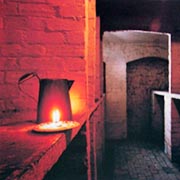32 Brunswick Square
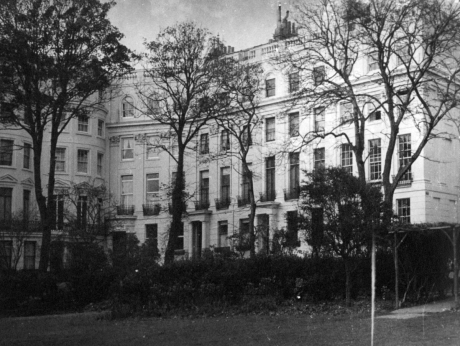
NW Corner of Brunswick Square 1940s from the Royal Pavilion and Museums Trust, Brighton
Number 32 Brunswick Square started life as number 30 and was renumbered along with most of Brunswick Square in 1834. Most of the early residents appear to have originally been from London and still maintained houses in the wealthier parts of the capital.
The first resident in 1827 appears to be Joseph Faulder Esquire who contracts with the Reverend Thomas Scutt to obtain the property. In June 1831 the property is sold to the sisters, Elizabeth and Sophia Mordaunt, spinsters of Upper Berkeley Street, Portman Square, Middlesex. The sisters are clearly involved in the local social scene as the Brighton Gazette’s Fashionable Entertainments section advertises their evening party at 30 Brunswick Square. It’s interesting to note that they were competing in the fashionable party stakes with Maria Fitzherbert, the ‘widow’ of the recently deceased King George IV.
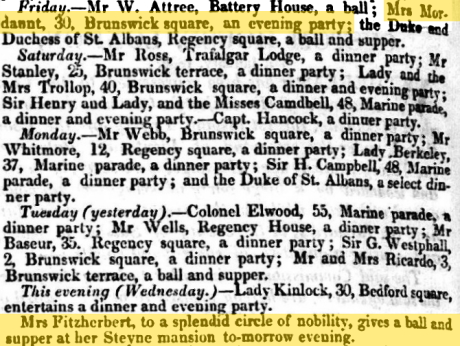
Brighton Guardian 25 January 1832
The sisters are still in residence in 1833, and are involved in a financial transaction, probably a mortgage, with George Basevi of 35 Brunswick Square and Sir John Gibney, a medical doctor of Brighton.
George Basevi was one of the original Brunswick Commissioners from 1830 and together with his son made a significant contribution to Hove. From 1836 to 1851 he was also on the Magistrates Bench and, being an influential member of the community, must have helped when Hove Parish were looking for someone to restore St Andrews. He recommended his architect son, also George Basevi.
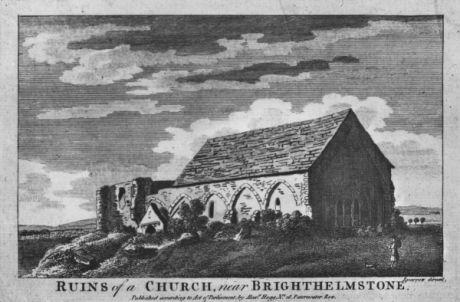
St Andrews in ruins in 1720
George Basevi junior (1794 to 1845) was a renowned architect who worked in Brighton, Cambridge and London. He predeceased his father in 1845 when he fell from the tower of Ely Cathedral whilst inspecting some work.

Brighton Gazette - Thursday 17th October 1833 - 30 Brunswick Square (now 32)
Our house, still number 30 at this point, is advertised for rent on 17th October 1833; it’s available for three to twelve months.
A few years later in 1839 the house is sold to William Hart who lives there until 1846.
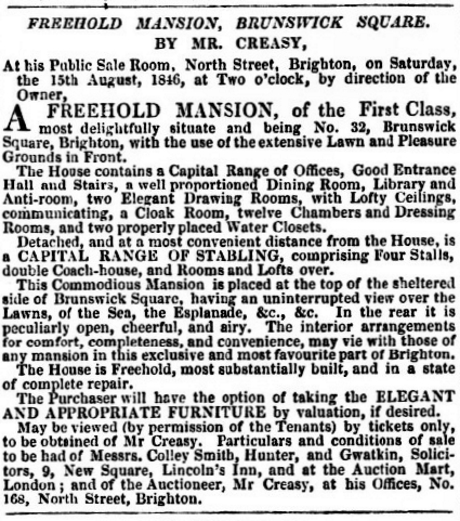
Brighton Gazette 16th July 1846 - Particulars of sale.
The stables in the sales particulars are clearly much bigger than most of the stables in the street. Unlike the other houses, these are not connected to the house but the estate agent’s jargon describes them as being at a most convenient distance from the House.
Following the death of William Hart, a conveyance dated 12th October 1846 transfers the property to Arthur Lewis. The Lewis family is in residence at the 1851 census and members of the same family remain there until the death of Arthur’s daughter Elizabeth on 22nd March 1895, nearly 50 years of occupation by members of the same family.
There are 19 people in the house in 1851 including three generations of the Lewis family.
- Arthur Lewis, Married, 68, Retired Merchant, Middlesex
- Mary Lewis, Married, 62, Surrey
- Emily Lewis, Unmarried, 21, Surrey
- Arthur Lewis, Visitor, Married, 35, Annuitant, Surrey
- Elizabeth Mackay, Daughter, Married, 28, Surrey
- Macgregor Mackay, Son-in-law, Married, 38, Annuitant, Scotland
- Matilda Foster, Daughter, Married, 27, Surrey
- Thomas Foster, Son-in-law, Married, 33, Wine Merchant, Middlesex
- Louisa Foster, Granddaughter, 8, At school at home, Middlesex
- Frederick Foster, Grandson, 6, At school at home, Middlesex
- Edmond Foster, Grandson, 4, Surrey
- Harry Foster, Grandson, 3, Surrey
- Helen Foster, Granddaughter, 1, Surrey
- Lucy Gumbrill, Servant, Unmarried, 25, House Servant, Sussex
- Helen Graham, Servant, 44, House Servant, Scotland
- Mary Brooks, Servant, 26, House Servant, Somerset
- Mary Oliver, Servant, 27, House Servant, Middlesex
- Mary Good, Servant, 17, House Servant, Surrey
- Thomas Holiday, Servant, 29, Footman, Surrey
The stables for number 32 appear not to be used by the owners of 32 for the period of the Lewis’s occupation. There are no mentions of residents of the stables or of horse management staff in the main house between 1841 and 1881. However, between 1856 and 1870, the poll books show the stables as being in the occupation of Lady Hotham, presumably leased by her for her own use.
James MacGregor Mackay married Arthur Lewis’s daughter Elizabeth and was resident in the house with the rest of the family in 1851. He’s in London with wife, Elizabeth, and two servants in 1861, giving his profession as 'Foreign and Colonial Merchant'. They’re back in number 32 by the 1871 census following the death of Arthur Lewis in 1870. James is still at 32 in the 1880 electoral roll.
One of the MacKay’s servants is Helen Graham from Ross & Cromerty in the Highlands of Scotland. It seems likely that she followed James MacGregor down from Scotland as they’re from a similar part of the country. In 1881 Helen is still with the family at the age of 65, apparently still unmarried.
Another servant in 1851 is Lucy Gumbrill, aged 25 from Billingshurst, Sussex. Lucy appears to have been a servant all her life from the age of 16 starting in her home village of Billingshurst. She was presumably attracted to Brunswick Square by better prospects. She married in 1852 and is not there in the next census. This is not unusual as the owners of the house generally liked their servants to be completely focussed on their duties in the house.
There was plenty of debate in the town about whether Brighton should be incorporated as a Borough. Arthur Lewis appears to have been against it.
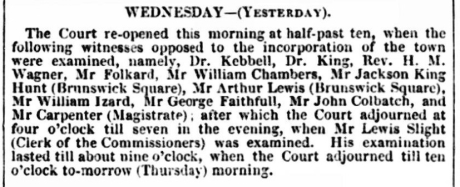
1852-10-07 Brighton Gazette - Arthur Lewis opposing incorporation of Brighton
Arthur was clearly active in the local community being a governor of the Sussex County Hospital as well as having views on the town’s incorporation.
The hospital at that time was supported by voluntary contributions and, presumably, Arthur was involved in fundraising and controlling the finances.
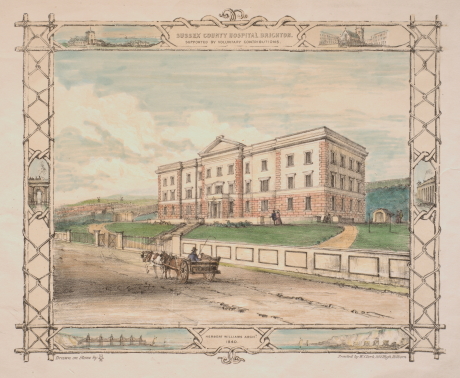
The Sussex County Hospital in 1840
James dies in 1880 leaving Elizabeth to run the family home. On 9th July 1882 she married Robert Upperton from 7 Lansdowne Place, just around the corner, but is widowed again by 1891.
An advert is placed in the London Evening Standard on 17th July 1895 advertising No. 32 for sale. The advert includes the capital stabling in the rear, actually on Brunswick Street West.
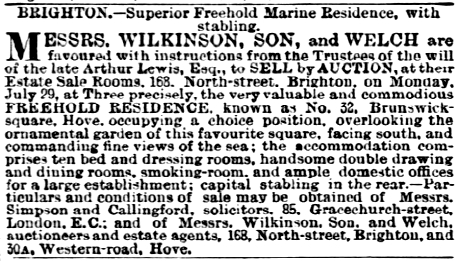
London Evening Standard 17 July 1895 Sale of 32 Brunswick Square -
In December 1895, following Elizabeth’s death, the house is sold to Frederic Stansfield Herries who is recorded as being a Lieutenant Colonel. Herries is also recorded as living at 36 Lansdown Place, Brighton, and a retired officer of the 65th Regiment. The sale price is £3,750.
The conveyance of 1896 shows the plan of the property, including the stables in Brunswick Street West linked by a path behind Western Road.
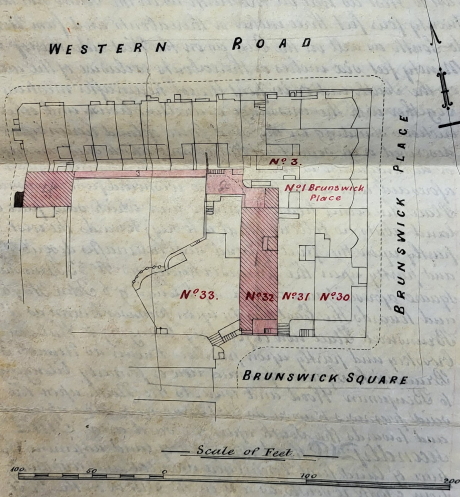
1896 Conveyance from WHITLARK to HERRIES
Frederick Stansfield Herries was born in West London in 1833. His parents must have been wealthy as they commissioned a painting of him at the age of two in 1835. Apparently, clothing boy toddlers in dresses made the process of potty training significantly easier as parents were able to change the toddler’s nappies without undressing them, lifting their skirts would suffice.
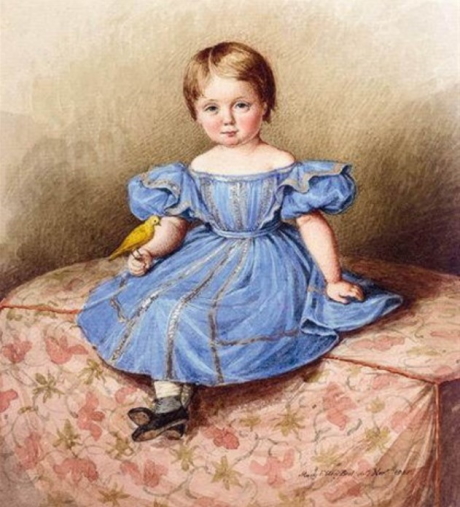
Portrait of Frederick Stansfield Herries, 1835 by Mary Ellen Best
Frederick had a military career which took him to New Zealand where he married his first wife, Jane Maria Gray and where their daughter and son were born.
Following the death of his first wife, Frederick married Louisa Wilmot Doubuz in 1865 on the Isle of Wight. They then relocate to London for the birth of another son and daughter. Louisa died in 1882 and Frederick married for the third time, this time in Yorkshire, to Susanna Mary Hill.
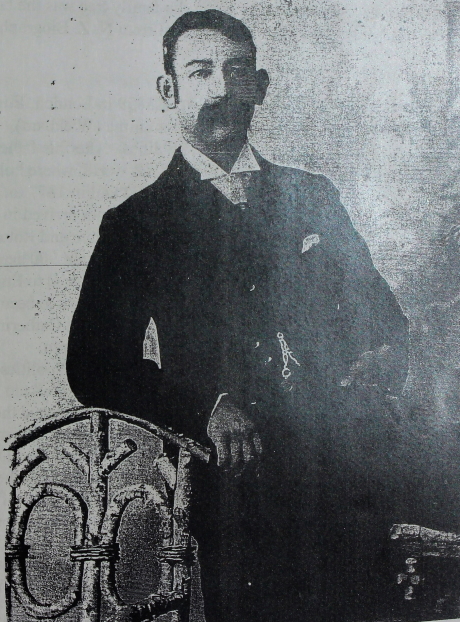
Colonel Frederick Herries in later years
Frederick moved to Brunswick Square in 1895 and remained there until his death in 1916.
These are the residents of 32 Brunswick Square in 1901:
- Frederick S Herries, Married, 67, Lt Col Retired, St George’s Middlesex
- Susanna Herries, Married, 61, Gosberton, Lincolnshire
- Edward Harris, Visitor, Married, 59, Living on own means, Northamptonshire
- Mary E Harris, Visitor, Single, 21, Living on own means, Lincolnshire
- William Galeton, Servant, Single, 28, Groom domestic, Lymington, Hampshire
- Matilda Barwick, Servant, Single, 48, Cook, Scotland
- Hannah Mills, House Servant, 32, London
- Alice M Carter, Under Housemaid, 19, London
- Emma ?
William Galeton, the domestic groom from Lymington, is presumably living in the main house but using the stables at the rear. At this time, George Castle, also from Lymington, is living in the stables with a coachman and his wife. I wonder if they were connected in some way?
Frederick was a member of the Hove Knights Imperial, a group whose members, according to the 11th June 1903 edition of the Brighton Gazette, had no special taste for politics in this country but still desire it to be properly governed. I wonder what they got up to?
By the 1911 census Frederick is described as a 'retired Lieutenant Colonel'.
One of the family’s servants in 1911 is Maggie Bounds, who was born in Brighton in 1893. Her family lived in Kemp Street from 1898 to 1904. At the time of the 1901 census her family consisted of Albert, Maggie’s father, his sister and five children, plus a couple presumably renting a room – a total of nine people in a two-up-two down terraced house.
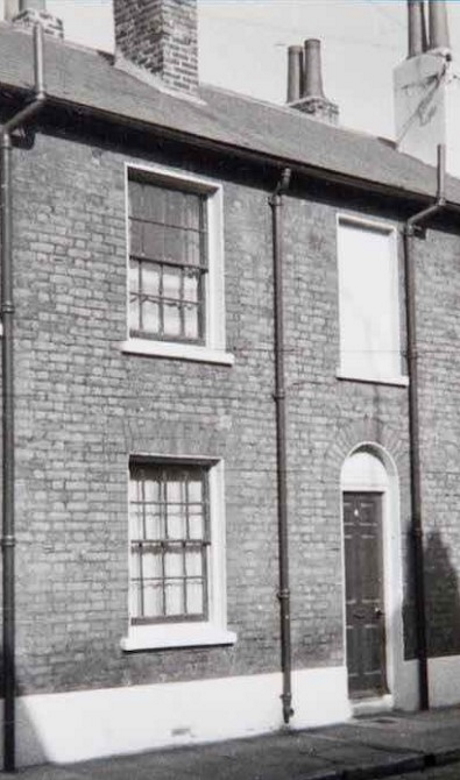
A typical house In Kemp Street
Maggie’s house was similar to this one in Kemp Street - the family must have been quite happy when Maggie found a job with her accommodation provided.
Given the wealth gap, the lives of the Herries familt must have been so different to that of their servants. In 1912, Frederick inherits £20,000 (around £1.75m today) from an Edward Herries of Sevenoaks. The news is reported in the Brighton Argus above a story about a meteor!
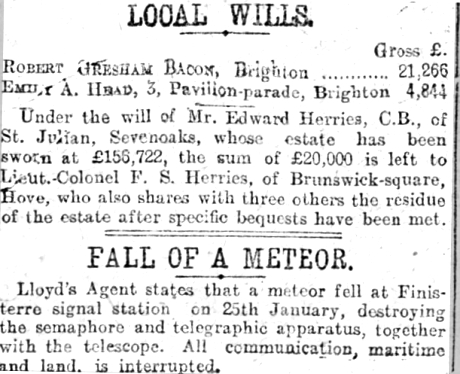
Brighton Argus 2 February 1912
Frederick died on 4th Nov 1916 and, it seems, practised some wealth-redistribution. Out of his estate valued at £29,734 (nearly £2m in 2022) he leaves the following amounts to his staff:
- £10 (approx. £700 now) to Rose Cordery, semptress (seamstress). This money certainly seems to have helped Rose as four years later the poll books show that she’s able to rent a house with two other people in Farm Road, Hove
- £10 (approx. £700 now) to Mary Flynn, charwoman
- £30 (approx. £2,000) per annum to George Lewis, coachman
- £30 (approx. £2,000) per annum to Matilda Barwick, housekeeper
- £26 (approx. £1,700) per annum to Annie Doncaster, servant
- £26 (approx. £1,700) per annum to Winifred Fletcher
- One year’s wages to all other staff in his employ
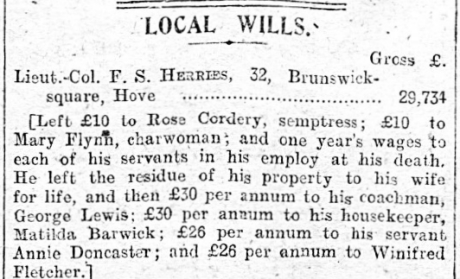
Sussex Daily News 18th April 1917
Research by Clive Reedman and Kevin Wilsher, 2023
Return to Brunswick Square page.


